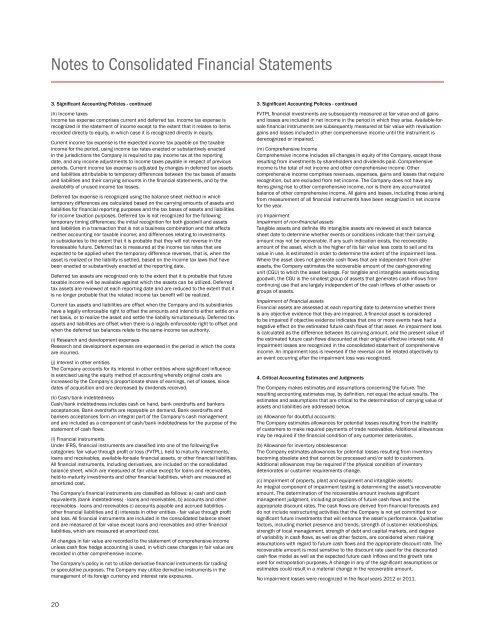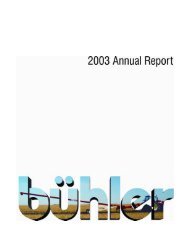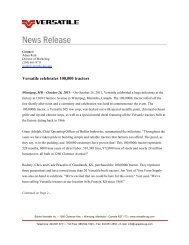complete financial statement - Buhler Industries Inc.
complete financial statement - Buhler Industries Inc.
complete financial statement - Buhler Industries Inc.
- No tags were found...
Create successful ePaper yourself
Turn your PDF publications into a flip-book with our unique Google optimized e-Paper software.
Notes to Consolidated Financial Statements3. Significant Accounting Policies - continued(h) <strong>Inc</strong>ome taxes<strong>Inc</strong>ome tax expense comprises current and deferred tax. <strong>Inc</strong>ome tax expense isrecognized in the <strong>statement</strong> of income except to the extent that it relates to itemsrecorded directly to equity, in which case it is recognized directly in equity.Current income tax expense is the expected income tax payable on the taxableincome for the period, using income tax rates enacted or substantively enactedin the jurisdictions the Company is required to pay income tax at the reportingdate, and any income adjustments to income taxes payable in respect of previousperiods. Current income tax expense is adjusted by changes in deferred tax assetsand liabilities attributable to temporary differences between the tax bases of assetsand liabilities and their carrying amounts in the <strong>financial</strong> <strong>statement</strong>s, and by theavailability of unused income tax losses.Deferred tax expense is recognized using the balance sheet method in whichtemporary differences are calculated based on the carrying amounts of assets andliabilities for <strong>financial</strong> reporting purposes and the tax bases of assets and liabilitiesfor income taxation purposes. Deferred tax is not recognized for the followingtemporary timing differences: the initial recognition for both goodwill and assetsand liabilities in a transaction that is not a business combination and that affectsneither accounting nor taxable income; and differences relating to investmentsin subsidiaries to the extent that it is probable that they will not reverse in theforeseeable future. Deferred tax is measured at the income tax rates that areexpected to be applied when the temporary difference reverses, that is, when theasset is realized or the liability is settled, based on the income tax laws that havebeen enacted or substantively enacted at the reporting date.Deferred tax assets are recognized only to the extent that it is probable that futuretaxable income will be available against which the assets can be utilized. Deferredtax assets are reviewed at each reporting date and are reduced to the extent that itis no longer probable that the related income tax benefit will be realized.Current tax assets and liabilities are offset when the Company and its subsidiarieshave a legally enforceable right to offset the amounts and intend to either settle on anet basis, or to realize the asset and settle the liability simultaneously. Deferred taxassets and liabilities are offset when there is a legally enforceable right to offset andwhen the deferred tax balances relate to the same income tax authority.(i) Research and development expensesResearch and development expenses are expensed in the period in which the costsare incurred.(j) Interest in other entitiesThe Company accounts for its interest in other entities where significant influenceis exercised using the equity method of accounting whereby original costs areincreased by the Company’s proportionate share of earnings, net of losses, sincedates of acquisition and are decreased by dividends received.(k) Cash/bank indebtednessCash/bank indebtedness includes cash on hand, bank overdrafts and bankersacceptances. Bank overdrafts are repayable on demand. Bank overdrafts andbankers acceptances form an integral part of the Company’s cash managementand are included as a component of cash/bank indebtedness for the purpose of the<strong>statement</strong> of cash flows.(l) Financial instrumentsUnder IFRS, <strong>financial</strong> instruments are classified into one of the following fivecategories: fair value through profit or loss (FVTPL), held to maturity investments,loans and receivables, available-for-sale <strong>financial</strong> assets, or other <strong>financial</strong> liabilities.All <strong>financial</strong> instruments, including derivatives, are included on the consolidatedbalance sheet, which are measured at fair value except for loans and receivables,held-to-maturity investments and other <strong>financial</strong> liabilities, which are measured atamortized cost.The Company’s <strong>financial</strong> instruments are classified as follows: a) cash and cashequivalents (bank indebtedness) - loans and receivables, b) accounts and otherreceivables - loans and receivables c) accounts payable and accrued liabilities -other <strong>financial</strong> liabilities and d) interests in other entities - fair value through profitand loss. All <strong>financial</strong> instruments are included in the consolidated balance sheetand are measured at fair value except loans and receivables and other <strong>financial</strong>liabilities, which are measured at amortized cost.All changes in fair value are recorded to the <strong>statement</strong> of comprehensive incomeunless cash flow hedge accounting is used, in which case changes in fair value arerecorded in other comprehensive income.The Company’s policy is not to utilize derivative <strong>financial</strong> instruments for tradingor speculative purposes. The Company may utilize derivative instruments in themanagement of its foreign currency and interest rate exposures.3. Significant Accounting Policies - continuedFVTPL <strong>financial</strong> investments are subsequently measured at fair value and all gainsand losses are included in net income in the period in which they arise. Available-forsale<strong>financial</strong> instruments are subsequently measured at fair value with revaluationgains and losses included in other comprehensive income until the instrument isderecognized or impaired.(m) Comprehensive <strong>Inc</strong>omeComprehensive income includes all changes in equity of the Company, except thoseresulting from investments by shareholders and dividends paid. Comprehensiveincome is the total of net income and other comprehensive income. Othercomprehensive income comprises revenues, expenses, gains and losses that requirerecognition, but are excluded from net income. The Company does not have anyitems giving rise to other comprehensive income, nor is there any accumulatedbalance of other comprehensive income. All gains and losses, including those arisingfrom measurement of all <strong>financial</strong> instruments have been recognized in net incomefor the year.(n) ImpairmentImpairment of non-<strong>financial</strong> assetsTangible assets and definite life intangible assets are reviewed at each balancesheet date to determine whether events or conditions indicate that their carryingamount may not be recoverable. If any such indication exists, the recoverableamount of the asset, which is the higher of its fair value less costs to sell and itsvalue in use, is estimated in order to determine the extent of the impairment loss.Where the asset does not generate cash flows that are independent from otherassets, the Company estimates the recoverable amount of the cash-generatingunit (CGU) to which the asset belongs. For tangible and intangible assets excludinggoodwill, the CGU is the smallest group of assets that generates cash inflows fromcontinuing use that are largely independent of the cash inflows of other assets orgroups of assets.Impairment of <strong>financial</strong> assetsFinancial assets are assessed at each reporting date to determine whether thereis any objective evidence that they are impaired. A <strong>financial</strong> asset is consideredto be impaired if objective evidence indicates that one or more events have had anegative effect on the estimated future cash flows of that asset. An impairment lossis calculated as the difference between its carrying amount, and the present value ofthe estimated future cash flows discounted at their original effective interest rate. Allimpairment losses are recognized in the consolidated <strong>statement</strong> of comprehensiveincome. An impairment loss is reversed if the reversal can be related objectively toan event occurring after the impairment loss was recognized.4. Critical Accounting Estimates and JudgmentsThe Company makes estimates and assumptions concerning the future. Theresulting accounting estimates may, by definition, not equal the actual results. Theestimates and assumptions that are critical to the determination of carrying value ofassets and liabilities are addressed below.(a) Allowance for doubtful accounts:The Company estimates allowances for potential losses resulting from the inabilityof customers to make required payments of trade receivables. Additional allowancesmay be required if the <strong>financial</strong> condition of any customer deteriorates.(b) Allowance for inventory obsolescence:The Company estimates allowances for potential losses resulting from inventorybecoming obsolete and that cannot be processed and/or sold to customers.Additional allowances may be required if the physical condition of inventorydeteriorates or customer requirements change.(c) Impairment of property, plant and equipment and intangible assets:An integral component of impairment testing is determining the asset’s recoverableamount. The determination of the recoverable amount involves significantmanagement judgment, including projections of future cash flows and theappropriate discount rates. The cash flows are derived from <strong>financial</strong> forecasts anddo not include restructuring activities that the Company is not yet committed to orsignificant future investments that will enhance the asset’s performance. Qualitativefactors, including market presence and trends, strength of customer relationships,strength of local management, strength of debt and capital markets, and degreeof variability in cash flows, as well as other factors, are considered when makingassumptions with regard to future cash flows and the appropriate discount rate. Therecoverable amount is most sensitive to the discount rate used for the discountedcash flow model as well as the expected future cash inflows and the growth rateused for extrapolation purposes. A change in any of the significant assumptions orestimates could result in a material change in the recoverable amount.No impairment losses were recognized in the fiscal years 2012 or 2011.20





